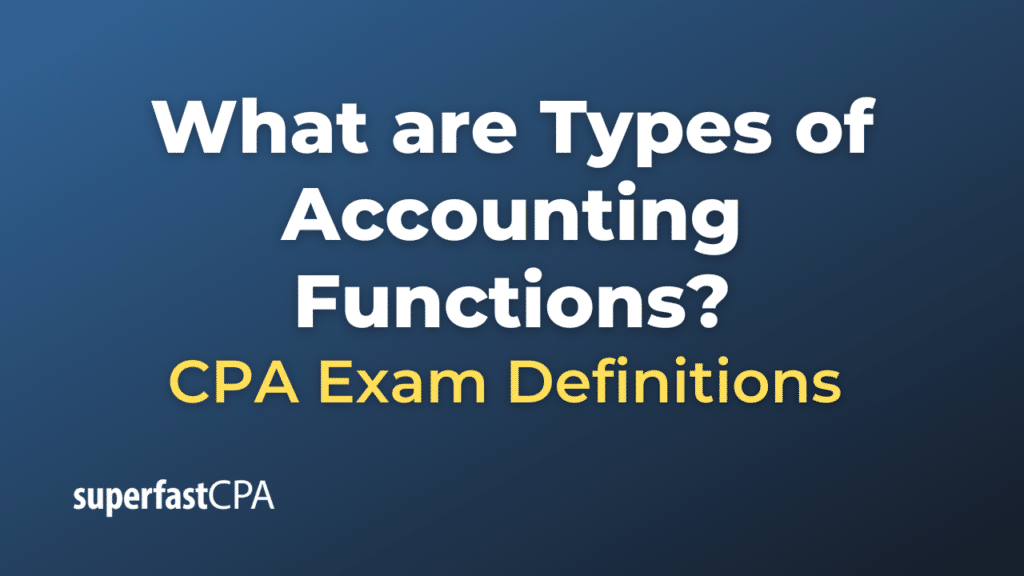Types of Accounting Functions
Accounting functions refer to the specific tasks, activities, and operations carried out within the accounting discipline. These functions ensure that an organization’s financial operations run smoothly and that its financial reports are accurate and timely. Here are the main types of accounting functions:
- Record Keeping (Bookkeeping):
- Involves maintaining systematic records of all financial transactions.
- Includes tasks like journalizing (recording transactions in a journal), posting to ledgers, and balancing accounts.
- Financial Reporting:
- Preparing financial statements, such as the income statement, balance sheet, statement of cash flows, and statement of changes in equity.
- These reports provide an overview of an organization’s financial performance and position.
- Accounts Receivable:
- Managing money that is owed to the company by its customers.
- Functions include invoicing, recording payments, and managing overdue accounts.
- Accounts Payable:
- Payroll:
- Managing the process of compensating employees.
- Includes calculating wages, withholding taxes, making necessary deductions, and distributing paychecks.
- Taxation:
- Preparing and filing tax returns.
- Ensuring compliance with local, state, and federal tax regulations.
- Planning strategies to minimize tax liabilities.
- Cost Accounting:
- Budgeting and Budgetary Control:
- Internal Auditing:
- Assessing and reviewing the organization’s financial and operational processes.
- Ensuring internal controls are effective and recommending improvements.
- Cash Management:
- Monitoring and managing the cash flows of the company.
- Ensuring there’s enough cash to meet short-term obligations and optimizing returns on excess cash.
- Financial Analysis:
- Evaluating the financial health of the company through ratios and metrics.
- Supporting management decisions with insights derived from financial data.
- Inventory Management:
Each of these functions plays a crucial role in an organization’s financial management, helping to maintain accurate records, make informed decisions, and ensure compliance with regulations.
Example of Types of Accounting Functions
Let’s use a hypothetical scenario involving a small business, “Bella’s Boutique,” to illustrate some of these accounting functions.
1. Record Keeping (Bookkeeping):
- Example: Every day, the store’s cashier records the day’s sales and expenses in a journal. At the end of the month, these entries are posted to the store’s general ledger.
2. Financial Reporting:
- Example: At the end of the fiscal year, Bella prepares a balance sheet to review her store’s assets, liabilities, and equity. She also prepares an income statement to see how much profit the boutique made during the year.
- Example: A regular customer, Mrs. Smith, buys a dress and decides to pay for it later. Bella invoices Mrs. Smith for the dress, and once paid, records the payment against the outstanding amount.
4. Accounts Payable:
- Example: Bella receives a shipment of new clothing from a supplier along with an invoice. She verifies the delivered items against the purchase order and then processes the payment before the due date.
5. Payroll:
- Example: Bella employs three staff members. Every month, she calculates their wages, deducts the appropriate taxes, and pays them their net salary, ensuring to record the payroll expenses.
6. Taxation:
- Example: As the tax season approaches, Bella compiles all her financial records and prepares her business tax returns. She makes sure to claim all allowable deductions to minimize her tax liability.
7. Budgeting and Budgetary Control:
- Example: At the beginning of the year, Bella forecasts her sales and expenses for the coming year. As months go by, she compares actual performance against these forecasts, adjusting her strategies accordingly.
8. Cash Management:
- Example: Bella reviews her boutique’s daily sales and expenses, ensuring she has enough cash on hand to cover immediate expenses and any unexpected costs. She also sets aside a portion of her profits in a high-yield savings account.
9. Inventory Management:
- Example: Bella uses an inventory management system to keep track of her stock levels. When certain items are running low, the system alerts her, ensuring she can reorder in time to prevent stockouts.
This scenario illustrates how various accounting functions play an essential role in the successful operation of Bella’s Boutique. While a larger organization would have more complex processes and might employ specialists for each function, the principles remain consistent.














